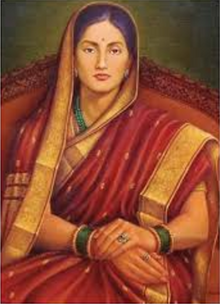Sai Bhonsale
| Maharani Saibai Bhosale | |
|---|---|
Rajmata Shrimant Chatrapati Saibai Shivajiraje Bhosale | |
 A 2012 artist's rendition of Maharani Saibai[1] | |
| Tenure | 1640-1659 |
| Successor | Soyarabai |
| Born | Saibai Nimbalkar c. 29 October 1633 Rajgad Fort, Pune, Maratha Empire (present-day Maharastra, India) |
| Spouse | |
Bhosale (by marriage) | |
| Father | Mudhoji Rao Naik Nimbalkar |
| Mother | Reubai |
| Religion | Hinduism |
Saibai Bhosale (née Nimbalkar) (c. 1633[1] – 5 September 1659) was the first wife and chief consort of Chattrapati Shivaji, the founder of the Maratha Empire. She was the mother of her husband's successor Chattrapati Sambhaji.
Family
Saibai was a member of the prominent Nimbalkar family, whose members were the rulers of Phaltan from the era of the Pawar dynasty[citation needed] and served the Deccan sultanates and the Mughal Empire. She was a daughter of the fifteenth Raja of Phaltan, Mudhojirao Naik Nimbalkar, and a sister of the sixteenth Raja, Bajaji Rao Naik Nimbalkar.[2] Saibai's mother Reubai was from the Shirke family.
Marriage
Rani Saibai and
Rani Saibai and Shivaji Raje shared a close relationship with each other. She is said to have been a wise woman and a loyal consort to him.[7] By all accounts, Saibai was a beautiful, good-natured, and affectionate woman. She is described as having been a "gentle and selfless person."[8]
All of her endearing personal qualities, however, were a sharp contrast to Shivaji‘s second wife, Soyarabai, who was an intriguing lady.[9][10] She also had significant influence over her husband and the royal family as well. Saibai is reported to have acted as a counsel to Shivaji when he was invited by Mohammed Adil Shah, the king of Bijapur, for a personal interview.[11] During Saibai's life time, the entire household of Shivaji bore a homogeneous atmosphere despite the fact that most of his marriages were performed due to political considerations.[10]
After Saibai's untimely death in 1659 followed by Jijabai's death in 1674, Shivaji's private life became clouded with anxiety and unhappiness.[12] Although Soyarabai had gained prominence in the royal household following their deaths, she was not an affectionate consort like Saibai, whom Shivaji had dearly loved.[13]
Saibai remained Shivaji's favorite till he died. A great source of inspiration to him, legend has it that "Sai" was the last word he uttered on his deathbed.[1]
Issue
During the course of their nineteen years of marriage, Saibai and Shivaji became parents of four children: Sakavarbai (nicknamed "Sakhubai"), Ranubai, Ambikabai, and
Death
Saibai died in 1659 in
In popular culture
- Literature - Shivpatni Saibai, a biography of Saibai's life written by Dr. Sadashiv Shivade.[17]
- Film- Umadevi Nadgonde, popularly known as Baby Shakuntala portrayed Saibai in the Marathi language 1955 film Chhatrapati Shivaji Maharaj [citation needed]
- Film- Smita Patil played Saibai in the 1974 film Raja Shiv Chhatrapati[citation needed]
- Film - Isha Keskar played Saibai in the 2022 Film Sher Shivraj directed by Digpal Digpal Lanjekar[citation needed]
- In Colors TV's 2012 historical drama, Veer Shivaji, Saibai was portrayed by an actress Palak Jain as a teenager and by Sonia Sharma as an adult.[citation needed]
- Television- Rujuta Deshmmukh portrays Saibai in the popular TV series, Raja Shivchatrapati which aired on Star Pravah. [citation needed]
- Television- Poorva Gokhale played Saibai in Swarajyarakshak Sambhaji, based on the life of Sambhaji[citation needed]
- Television- Saibai is portrayed by Samira Gujar-Joshi while Gargi Ranade plays the young Saibai in Swarajya Janani Jijamata based on the life of Jijabai[citation needed]
References
- ^ a b c Tare, Kiran (June 16, 2012). "First-ever portrait of Shivaji's queen to be unveiled soon". India Today. Retrieved February 27, 2013.
- ISBN 9788190200004.
- ^ Balkrishna Deopujari, Murlidhar (1973). Shivaji and the Maratha Art of War. Vidarbha Maharashtra Samshodhan Mandal. p. 35.
- ISBN 9780521268837.
- ISBN 9788128808265.
- JSTOR 44140420.
- ^ Sen, Surendra Nath (1930). Foreign Biographies of Shivaji Volume 2 of Extracts and Documents relating to Maratha History. K. Paul, Trench, Trubner & Company Limited. p. 165.
- ^ Kincaid, Dennis (1987). The History of Chh.Shivaji Maharaj: The Grand Rebel. Karan Publications. p. 78.
- ISBN 9788177552881.
- ^ ISBN 9788185616674.
- ISBN 9788185016498.
- ^ Sardesai, Govind Sakharam (1957). New History of the Marathas: Chh.Shivaji Maharaj and his line (1600-1707). Phoenix Publications. p. 263.
- ^ Kincaid, Dennis (1937). The Grand Rebel: An Impression of Chh.Shivaji Maharaj, Founder of the Maratha Empire. Collins. pp. 162, 176.
- ^ Charles Augustus Kincaid, Dattātraya Baḷavanta Pārasanīsa (1922). A History of the Maratha People: From the death of Chh.Shivaji Maharaj to the death of Shahu. S. Chand. p. 44.
- ^ Joshi, P.S. (1980). Chhatrapati Sambhaji, 1657-1689 A.D. S. Chand. pp. 3, 4.
- ISBN 9781932705546.
- ^ "Shivpatni Saibai, Sadashiv Sivade". Sahyadribooks.org. Retrieved 30 May 2013.
